PLACE
Trinity Test Site
LOCATION
White Sands Missile Base, New Mexico, U.S.A
AUTHOR
Articles and Pictures, Tony Hart-Wilden
HISTORY
At 5:29 a.m on July 16th 1945, the world’s first atomic bomb was tested at the Trinity Test Site in the White Sands Missile Base, in New Mexico. The blast was felt over a hundred miles away. Equal to 20,000 tons of T.N.T and generating heat 10,000 times hotter then the surface of the sun, everything within a mile of the bomb tower ceased to exist. The tower itself became liquid. Windows were shattered 120 miles away. The following month a second atomic bomb was dropped on Hiroshima, Japan. The McDonalds ranch house, where the bomb was developed can still be seen, and earth from the original bomb crater has been preserved at the site. Prolonged exposure to the high radiation levels at ground zero, are still considered dangerous over 50 years after the event.
The Trinity Test Site is only opened twice a year on the first Saturdays in April and October, so plan ahead. The nearest major airport is Albuquerque, and then it’s about a hundred mile drive. The 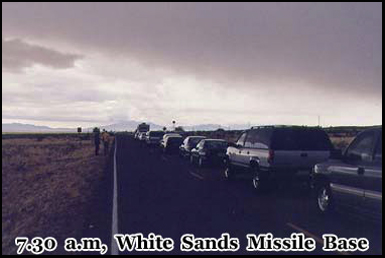 night I flew in, it was actually snowing. It’s not something that you expect to happen in the desert, but it didn’t last that long and any that had settled was gone by the next morning. From the direction I was coming from, the nearest place to find a motel is a town called Sorroco, then after that it’s another 20 mile drive to the site. I did book the motel in advance as people come from all over the world to be able to stand at the original “ground zero”. There are lots of cheap hotels/motels here and if you want to experience the Trinity Test Site before it’s completely overrun with people, its best to make an early start. I left the motel at about 6.45 am in the morning for the 8 am opening of the site. I arrived at Stallion gate, which is one of two entrances to the base, at about 7.30 am. I had expected to be one of the first in line at that time, but there were already about 15 to 20 cars and trucks ahead of me. As I waited, traffic built up, till they convoy was about 30 40 vehicles long.
night I flew in, it was actually snowing. It’s not something that you expect to happen in the desert, but it didn’t last that long and any that had settled was gone by the next morning. From the direction I was coming from, the nearest place to find a motel is a town called Sorroco, then after that it’s another 20 mile drive to the site. I did book the motel in advance as people come from all over the world to be able to stand at the original “ground zero”. There are lots of cheap hotels/motels here and if you want to experience the Trinity Test Site before it’s completely overrun with people, its best to make an early start. I left the motel at about 6.45 am in the morning for the 8 am opening of the site. I arrived at Stallion gate, which is one of two entrances to the base, at about 7.30 am. I had expected to be one of the first in line at that time, but there were already about 15 to 20 cars and trucks ahead of me. As I waited, traffic built up, till they convoy was about 30 40 vehicles long.
While I was waiting I got out and took a few pictures. If you look at the license plates on the cars you will notice that people have come to visit from all over the country. Aside from this 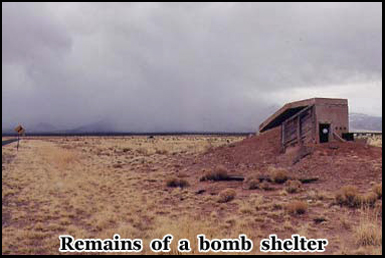 entrance there is also another one on the other side of the test range for people coming via Alamogordo. From there a convey is formed of cars and specially chartered coaches that will then proceed to the base under military escort. Both entrances are part of the White Sands Missile Base, which covers an area of about 3,200 square miles of the New Mexico desert. Once the gates open, exactly at 8 am, you drive to a checkpoint and are given a guide with a brief description of what you will see at the test site. There are a few regulations you are required to abide by, on what is still an active military installation. From this side, the 17 mile drive to ground zero is un-escorted, but you are not permitted to stop until you reach it. You are also warned not to take pictures of anything outside the test area itself. They also advise you not to pick up any of the solidified glass originally caused by the heat of the bomb blast, as this is still radioactive.
entrance there is also another one on the other side of the test range for people coming via Alamogordo. From there a convey is formed of cars and specially chartered coaches that will then proceed to the base under military escort. Both entrances are part of the White Sands Missile Base, which covers an area of about 3,200 square miles of the New Mexico desert. Once the gates open, exactly at 8 am, you drive to a checkpoint and are given a guide with a brief description of what you will see at the test site. There are a few regulations you are required to abide by, on what is still an active military installation. From this side, the 17 mile drive to ground zero is un-escorted, but you are not permitted to stop until you reach it. You are also warned not to take pictures of anything outside the test area itself. They also advise you not to pick up any of the solidified glass originally caused by the heat of the bomb blast, as this is still radioactive.
As you make the drive to the Trinity Test Site, you pass various single story buildings and hangers, and also several radar antennas. Then as you get nearer, ahead in the distance is a large fenced off area where the first of the cars in the convoy have stopped. Just before you reach the car park, on your right hand side there is what looks like the remains of a log cabin that has collapsed into a mound of earth. It is in fact what is left of a bunker that dates back to 1945 when the bomb test occurred. It was actually built to hold instruments rather then people. But what is interesting is how close it actually is to ground zero. I parked the car outside the walkway to the test site itself. There were no permanent amenities as the location is only open twice a year to members of the public. There’s a ro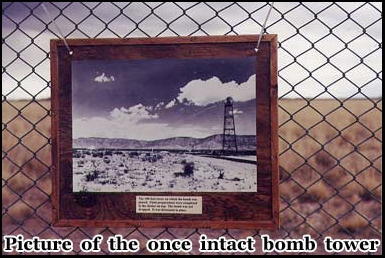 w of portable toilets, and a single stall selling hot dogs and hamburgers. There’s also a couple of vendors selling souvenir Trinity Test Site t-shirts, post cards and guidebooks. The weather is very cold, and if you look over towards the rear of the site, you see mist and snow covered mountains. Just before you enter the main walkway there is a large rusty steel cylinder with jagged broken ends. This is known as “Jumbo”, it was meant to be a protective outer case around the bomb. The actual detonation was a two part process, initially T.N.T, and then a moment later the plutonium would be triggered. The casing was meant to contain the plutonium in the event of a misfire, as this would have contaminated the surrounding area. In the end it was decided not to use it and the damage to the cylinder was done by the army who used it to develop explosives in 1946. The atomic bomb was not actually developed here at the Trinity Test Site but several hundred miles away in the north of the state. This was where the Los Alamos research facility was established. Dr J Oppenheimer lead the team responsible for its further development after initial research was conducted by the Manhattan project in 1942. This was where the race began to beat Germany in the construction of the world’s first atomic bomb.
w of portable toilets, and a single stall selling hot dogs and hamburgers. There’s also a couple of vendors selling souvenir Trinity Test Site t-shirts, post cards and guidebooks. The weather is very cold, and if you look over towards the rear of the site, you see mist and snow covered mountains. Just before you enter the main walkway there is a large rusty steel cylinder with jagged broken ends. This is known as “Jumbo”, it was meant to be a protective outer case around the bomb. The actual detonation was a two part process, initially T.N.T, and then a moment later the plutonium would be triggered. The casing was meant to contain the plutonium in the event of a misfire, as this would have contaminated the surrounding area. In the end it was decided not to use it and the damage to the cylinder was done by the army who used it to develop explosives in 1946. The atomic bomb was not actually developed here at the Trinity Test Site but several hundred miles away in the north of the state. This was where the Los Alamos research facility was established. Dr J Oppenheimer lead the team responsible for its further development after initial research was conducted by the Manhattan project in 1942. This was where the race began to beat Germany in the construction of the world’s first atomic bomb.
On the chain link fence there was once a warning sign that read “the use of eating, drinking, chewing and smoking materials and the application of cosmetics is prohibited within this fenced area”. This sign was eventually removed as of 1999 as the army deemed it no longer necessary. However 50 years after the blast the area still has a radiation level ten times higher then normal. And you do have to sign a liability waver before you enter the location, but this is not related to radiation exposure. One thing they do warn you about is a substance called 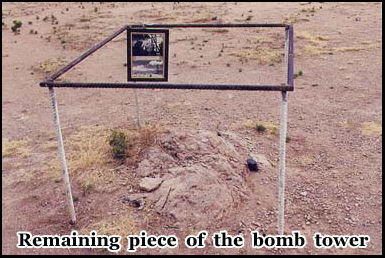 Trinitite, this looks like green pieces of glass that is basically sand melted by the nuclear blast. These pieces do contain high radiation levels, so you are advised not to take any pieces home as souvenirs. Now it’s only a short walk to ground zero. Again this is not one of those places that there’s going to be lots to see, the obvious reason being that it all got obliterated by an atomic bomb. But it’s the significance of actually being at the exact location that something that had such a monumental effect on the world occurred. Up ahead of you there is a black granite monument, already people are having their pictures taken in front of it. This is ground zero; it is at this exact point that the age of the atomic bomb was thrust upon history. It looks very stark and cold. In the far distance there is a snow covered mountain range. But directly in front of you the grass no longer seems to grow, and there are just bare patches of what was once scorched earth.
Trinitite, this looks like green pieces of glass that is basically sand melted by the nuclear blast. These pieces do contain high radiation levels, so you are advised not to take any pieces home as souvenirs. Now it’s only a short walk to ground zero. Again this is not one of those places that there’s going to be lots to see, the obvious reason being that it all got obliterated by an atomic bomb. But it’s the significance of actually being at the exact location that something that had such a monumental effect on the world occurred. Up ahead of you there is a black granite monument, already people are having their pictures taken in front of it. This is ground zero; it is at this exact point that the age of the atomic bomb was thrust upon history. It looks very stark and cold. In the far distance there is a snow covered mountain range. But directly in front of you the grass no longer seems to grow, and there are just bare patches of what was once scorched earth.
To give some idea of the power of the blast, the bomb flash was visible 230 miles away where people 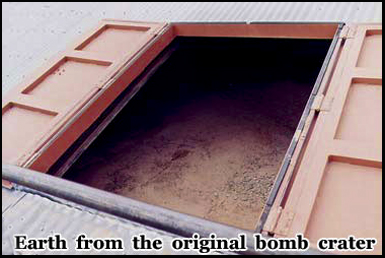 watched from Los Alamos. Over two hundred tons of sand were vaporized forming a vast dust cloud and the heat was so intense that one witness described it like opening an oven door, although he was ten miles away. The bomb itself was equivalent to 2000 B29 bombers dropping their maximum payload simultaneously onto a single spot. People felt the shockwaves 160 miles away. The official explanation the army gave to the civilian population was that a ammunition storage dump exploded. It was not until the first atomic bomb was dropped on Hiroshima that the government revealed the true nature of the Trinity Test Site. The nearest witnesses to the blast including Dr Oppenheimer, were stationed at bunkers over five miles away, they watched the explosion through darkly tinted welders goggles. Immediately after the blast a Sherman tank lined with two inches of lead to protect its occupants from radiation was sent out to inspect the site.
watched from Los Alamos. Over two hundred tons of sand were vaporized forming a vast dust cloud and the heat was so intense that one witness described it like opening an oven door, although he was ten miles away. The bomb itself was equivalent to 2000 B29 bombers dropping their maximum payload simultaneously onto a single spot. People felt the shockwaves 160 miles away. The official explanation the army gave to the civilian population was that a ammunition storage dump exploded. It was not until the first atomic bomb was dropped on Hiroshima that the government revealed the true nature of the Trinity Test Site. The nearest witnesses to the blast including Dr Oppenheimer, were stationed at bunkers over five miles away, they watched the explosion through darkly tinted welders goggles. Immediately after the blast a Sherman tank lined with two inches of lead to protect its occupants from radiation was sent out to inspect the site.
One thing I did find surprising is that the bomb didn’t actually create a deep crater in the ground, but I later discovered that it did create one of about ten feet in depth but most of it was subsequently filled in after the test. The bomb was in fact designed to explode outwards rather then downwards in order to cause maximum destruction. Right next to the ground zero monument th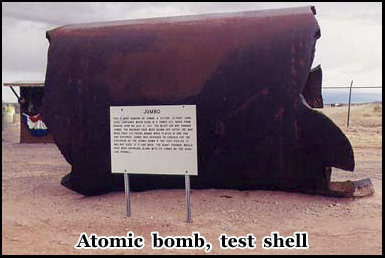 ere is what appears to be a small piece of metal sticking out of the ground between some rubble, surrounded by a small iron frame. This is the only remaining piece of the tower that the bomb was suspended on a 100 feet above the ground, everything else was liquefied in the intense heat. There is an old black and white picture hung on the protective frame that shows the bomb tower when it was intact, so you can imagine it once stretched up into the sky above you. If you go to the official military Trinity Test Site web page there is an interesting section on the myths and rumors that have grown up around the site. One of them is that the bomb was dropped from the test tower to achieve detonation, this was not the case. It was detonated remotely to explode where it was, secured 100 feet in the air. When the atomic bombs dropped on Hiroshima and Nagasaki they were detonated at a point several hundred feet above the ground as it was calculated the shockwaves would actually bounce back off the ground, rather then being absorbed by it, and thus cause more damage.
ere is what appears to be a small piece of metal sticking out of the ground between some rubble, surrounded by a small iron frame. This is the only remaining piece of the tower that the bomb was suspended on a 100 feet above the ground, everything else was liquefied in the intense heat. There is an old black and white picture hung on the protective frame that shows the bomb tower when it was intact, so you can imagine it once stretched up into the sky above you. If you go to the official military Trinity Test Site web page there is an interesting section on the myths and rumors that have grown up around the site. One of them is that the bomb was dropped from the test tower to achieve detonation, this was not the case. It was detonated remotely to explode where it was, secured 100 feet in the air. When the atomic bombs dropped on Hiroshima and Nagasaki they were detonated at a point several hundred feet above the ground as it was calculated the shockwaves would actually bounce back off the ground, rather then being absorbed by it, and thus cause more damage.
Something else which is particularly surprising on the military web site, myths and rumors section is the acknowledgement of what they refer to as a new age rumor. This is a direct quote from the site “we have heard it said that the energy released in the trinity test site explosion, since it was the first one, created a bubble over the site which is void of evil. Supposedly when you are at ground zero, you have a feeling of calm, and wish goodwill towards other visitors”. They then go on somewhat 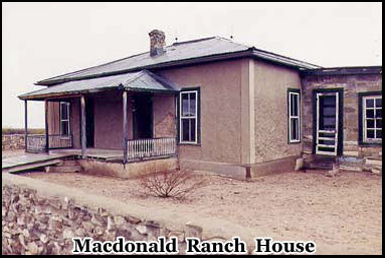 tongue in check to say they have no instruments to measure this supposed phenomenon. Personally at this time, I just felt cold, as the wind was sweeping in from the snow capped mountains. There is no guided tour around the site, but you can work your way around it at your own pace. Just to the right of the remaining leg of the test tower the perimeter of the surrounding fence continues. There is a series of about twenty black and white photographs. They depict the bomb itself and the test site at various different stages. They are interesting in their own right. But then when you think where you are, and you can still recognize the same landmarks 50 years later they take on much more significance. You look at the men in the pictures and then you can walk literally in their same footsteps. You also think that the next time a atomic bomb was used it wasn’t a test but was actually dropped onto a densely populated city not detonated out in a desert wasteland.
tongue in check to say they have no instruments to measure this supposed phenomenon. Personally at this time, I just felt cold, as the wind was sweeping in from the snow capped mountains. There is no guided tour around the site, but you can work your way around it at your own pace. Just to the right of the remaining leg of the test tower the perimeter of the surrounding fence continues. There is a series of about twenty black and white photographs. They depict the bomb itself and the test site at various different stages. They are interesting in their own right. But then when you think where you are, and you can still recognize the same landmarks 50 years later they take on much more significance. You look at the men in the pictures and then you can walk literally in their same footsteps. You also think that the next time a atomic bomb was used it wasn’t a test but was actually dropped onto a densely populated city not detonated out in a desert wasteland.
Although the bomb itself was many years in development, it was only a matter of days before the first major test after it had been built. July 16th 1945 was the date of the Trinity Test Site explosion, and on August 9th 1945 Hiroshima were bombed. At the site the first of several coach loads of visitors had arrived. Over the course of the day almost 2000 people would visit, and the other open day in October would attract about the same number. I continued walking anti-clockwise around the perimeter of the test site. The next place you come to is the crater shelter. It’s a large low level building with little more then a slopping roof sticking up a few feet above the ground. Every few feet there are double shutters that are opened up enabling you to look inside. If you look into the opening you will just see earth, but it’s at a level a few feet below the one which you are now standing on. In fact what the bunker protects is earth that was there at the time the bomb blast took place in 1945. Since that time the rest of the site had been bulldozed over with fresh earth and the shallow crater filled in order to minimize the risk of radiation contamination. Although what the bunker protects is just earth, that earth is one of the few remaining artifacts from the event. The test site exhibits themselves do have a makeshift feel to them. But in this case anything like a permanent gift shop or exhibit center would detract from the reality of the event that had taken place. And it must also be remembered that three hundred and sixty three days a year this area and the hundreds of miles around it is in fact a operational military base.
I walk on back the quarter mile to the car park, it is about 10 am now, and it is about half full and there are at least a few hundred people wandering around by this time. Aside from the Trinity Test Site itself the other major attraction is two miles away at what is referred to as the McDonald ranch house. This is where scientists assembled the plutonium core of the bomb 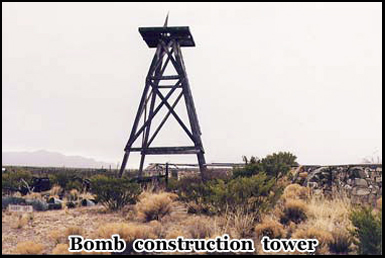 before inserting it into the main device at the test site itself. There are a series of coaches that leave the car park every few minutes that shuttle the visitors back and forth to the ranch house. I got on one of them, and it was about a ten minute drive on a small paved road through the desert. As you get of the bus there is a sign warning you to beware of rattlesnakes, then there is a short walk to what is a small single story house, with a low brick wall running around it. It is referred to as the McDonald ranch house after a rancher called George McDonald who was the last person to live there before it became part of the Alamogordo bombing and gunnery range in 1942. It lay empty until 1945 when it was then occupied by the Manhattan project scientists, working on the final developments of the atomic bomb. There are various black and white pictures and diagrams relating to life in the house during that time it was once the master bedroom. In the north east corner of the house that work benches were once installed and the plutonium core assembled. The doors and windows were sealed with tape and plastic to keep the sand out. In the few moments that the men spent not working on the bomb they were outside using one of the sections of a water storage tank as a makeshift swimming pool.
before inserting it into the main device at the test site itself. There are a series of coaches that leave the car park every few minutes that shuttle the visitors back and forth to the ranch house. I got on one of them, and it was about a ten minute drive on a small paved road through the desert. As you get of the bus there is a sign warning you to beware of rattlesnakes, then there is a short walk to what is a small single story house, with a low brick wall running around it. It is referred to as the McDonald ranch house after a rancher called George McDonald who was the last person to live there before it became part of the Alamogordo bombing and gunnery range in 1942. It lay empty until 1945 when it was then occupied by the Manhattan project scientists, working on the final developments of the atomic bomb. There are various black and white pictures and diagrams relating to life in the house during that time it was once the master bedroom. In the north east corner of the house that work benches were once installed and the plutonium core assembled. The doors and windows were sealed with tape and plastic to keep the sand out. In the few moments that the men spent not working on the bomb they were outside using one of the sections of a water storage tank as a makeshift swimming pool.
The house itself is only about two miles from ground zero. But despite the blast it remained largely intact, although the windows were all blown out. You always imagine that something as complex and of such significance would have taken place in more elaborate surroundings. But its proximity to the bomb site, and the urgency of the mission meant that it was decided to use an already existing 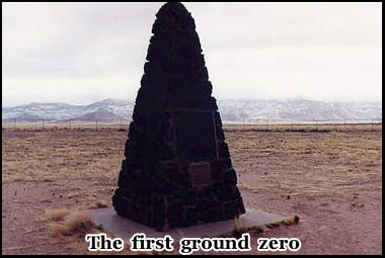 structure, rather then have something purpose built. The house itself actually fell into disrepair after the bomb blast. But after many years its historical significance was realized and in 1982 the task of restoring the house to its former condition was begun, and finished a few years later. There are only a few rooms to walk around, but there is a lot of information to take in. Aside from the pictures there are blueprints, and descriptions of the process for building the bomb, and if you walk out back to the rear of the house you can see where the remains of a barn are. This structure was damaged by the bomb blast, and eventually the roof of it caved in. I walked back out to the road and waited for the bus to take me back to the car. The next stop on the trip was Lincoln, where Billy the kid shot his way out of jail. Then after that, another’s hour’s drive and I would be paying a visit to Roswell, site of the legendary 1947 UFO crash.
structure, rather then have something purpose built. The house itself actually fell into disrepair after the bomb blast. But after many years its historical significance was realized and in 1982 the task of restoring the house to its former condition was begun, and finished a few years later. There are only a few rooms to walk around, but there is a lot of information to take in. Aside from the pictures there are blueprints, and descriptions of the process for building the bomb, and if you walk out back to the rear of the house you can see where the remains of a barn are. This structure was damaged by the bomb blast, and eventually the roof of it caved in. I walked back out to the road and waited for the bus to take me back to the car. The next stop on the trip was Lincoln, where Billy the kid shot his way out of jail. Then after that, another’s hour’s drive and I would be paying a visit to Roswell, site of the legendary 1947 UFO crash.
Trinity Atomic Bomb Site – Atlas Obscura
The Gadget- The First Atomic Bomb 1945 – Rare Historical Photos
White Sands Missile Range Museum – WSMR History
The Manhattan Project Trinity Test – Youtube
Bombing Of Hiroshima And Nagasaki – History
Building The Atom Bomb – The Full Story – The Guardian


Leave a Reply